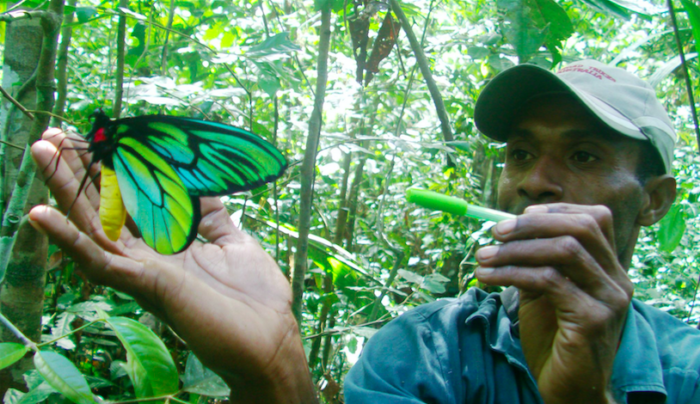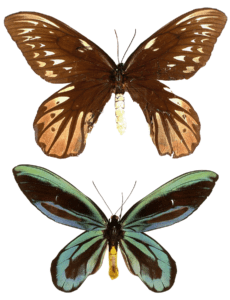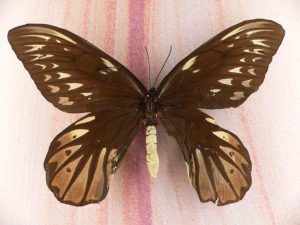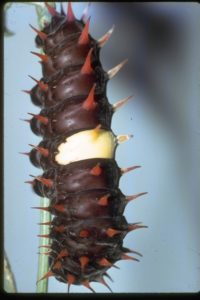- Zoology
- Daily Critter Facts
- For Teachers
- Study Guides
- Diseases & Parasites
- Contact

BUTTERFLY
BUTTERFLY

When it comes to butterflies, I find it hard to beat a morpho. However, when it comes to size…? Ornithoptera alexandrae, the Queen Alexandra’s birdwing, is the largest butterfly in the world, with females reaching wingspans slightly in excess of 9.8 inches.
 The species is endangered, and is one of only three insects (the other two being butterflies as well) to be listed on Appendix I of CITES, making international trade illegal. This birdwing is restricted to the forests of the Oro Province in eastern Papua New Guinea.
The species is endangered, and is one of only three insects (the other two being butterflies as well) to be listed on Appendix I of CITES, making international trade illegal. This birdwing is restricted to the forests of the Oro Province in eastern Papua New Guinea.
History
The species was named by Walter Rothschild in 1907, in honor of Alexandra of Denmark. The first European to discover the species was Albert Stewart Meek in 1906, a collector employed by Walter Rothschild to collect natural history specimens from New Guinea. Although the first specimen was taken with the aid of a small shotgun, Meek soon discovered the early stages and bred out most of the first specimens.
Description
Female: Female Queen Alexandra’s birdwings are larger than males with markedly rounder, broader wings. The female can reach, and slightly exceed, a wingspan of 9.8 inches, a body length of 3.1 inches and a body mass of up to 0.42 ounce, all enormous measurements for a butterfly. The female has brown wings with white markings arranged as two rows of chevrons. The hind-wings are brown with a submarginal line of centered yellow triangles. The body is cream colored and there is a small section of red fur on the brown thorax.
 Male: There is sexual dimorphism in this species. The wings are long with angular apices. They are iridescent bluish green with a black central band. There is a pronounced sex brand. The underside is green or blue green with black veins. Males are smaller than females. The abdomen is bright yellow. The wingspan of the males is approximately 8 inches, but more often about 6.3 inches. A spectacular form of the male is form atavus, which has gold spots on the hind wings.
Male: There is sexual dimorphism in this species. The wings are long with angular apices. They are iridescent bluish green with a black central band. There is a pronounced sex brand. The underside is green or blue green with black veins. Males are smaller than females. The abdomen is bright yellow. The wingspan of the males is approximately 8 inches, but more often about 6.3 inches. A spectacular form of the male is form atavus, which has gold spots on the hind wings.
Eggs
The eggs are large, light yellow and flattened at the base, fixated to the surface on which they are laid by a bright-orange substance. Under ideal conditions, the female Queen Alexandra’s birdwing is capable of laying over 240 eggs throughout its life.
Larva
Newly emerged larvae eat their own eggshells before feeding on fresh foliage. The larva is black with red tubercles and has a cream-colored band or saddle in the middle of its body.
Larvae of this species feed on the shell from which they hatched and then start to extract nutrients from pipe vines of the genus Pararistolochia. They feed initially on fresh foliage of the host plants and their own eggs, ultimately causing ringbark to the vine before pupating. Plants of the family Aristolochiaceae contain aristolochic acids in their leaves and stems. This is believed to be a potent vertebrate poison and is accumulated by larvae during their development.
Pupa
The pupa is golden yellow or tan in color with black markings. Male pupae may be distinguished by a faint charcoal patch on the wing cases; this becomes a band of special scales in the adult butterfly called a sex brand. The time taken for this species to develop from egg to pupa is approximately six weeks, with the pupal stage taking a month or more. Adults emerge from the pupae early in the morning while humidity is still high, as the enormous wings may dry out before they have fully expanded if the humidity drops.
A side note… I know the video clip is not of a Queen Alexandra’s birdwing.


